Valerie Coffey, Science Writer
Polymer optics are taking everyday applications by storm, thanks to advances that make plastic more and more competitive with glass.
Polymer optics have long been known for being inexpensive and low in optical quality. The ease of high-volume, low-cost manufacturing meant that just a few decades ago, consumers would find them primarily in disposable toys, diffraction-grating glasses and $5 film cameras. As materials, engineering design and tooling improved between the mid-1990s and the middle of the past decade, plastic grew to be common in more high-end optical applications, including fiber optics, biomedical devices, biometric scanning, and the displays and devices used in defense and homeland security.1
This flexibility of plastic optics is in large part the result of polymer optics manufacturers using sophisticated injection-molding and -testing techniques. Injection molding allows a polymer to be replicated from a master or metal inserts into complex optics such as Fresnel lenses, aspheres, toroids, free-form and micro-optics in a cost-effective, high-volume process (Figure 1).2
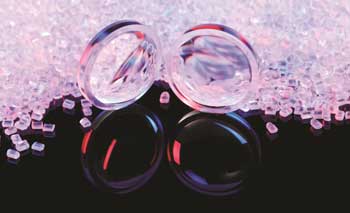
Figure 1. Thermoplastic molding pellets, the source material for injection molding, are melted to form finished molded lenses for numerous everyday applications, from cellphone cameras to LED lens assemblies.
Specifying plastic
When it comes to thermoplastics, the specifications are the same as for glass. Designers must call out the dimensions, surface accuracy, index of refraction, Abbe number and transmission characteristics. They also must consider inherent autofluorescence characteristics and likely stress birefringence. Surface coating selection depends on the spectral environmental conditions of the application.
Whether a design uses plastic or glass, however, depends upon understanding the widely varying strengths of glass and plastic, according to Scott Cahall, president of the optical design firm Moondog Optics Inc. in Fairport, N.Y. Glass comes in a wide variety of materials that can be chosen to optimize properties such as high refractive index, low dispersion or transmission over a broad spectrum. Glass enables tighter tolerances on material properties, while featuring a lower coefficient of thermal expansion and change of index with temperature (dn/dT) compared with plastic. Glass offers more resistance to surface abrasion and heat than plastic.
Besides being “formable” into unique optical elements such as double-sided microlens arrays and prisms with optical power (Figure 2), strengths of plastic include the ability to incorporate significant departures from spherical surfaces, which facilitates aberration correction and reduces element count, Cahall said. Plastic has a low mass compared with glass for a given optical power and can weigh up to five times less. A big advantage of plastic optics is that they can incorporate built-in features for mounting or other functionality, potentially eliminating parts from an assembly. Whereas glass is created in small batches at best, plastic has cost-effective scalability up to mass-production volumes.
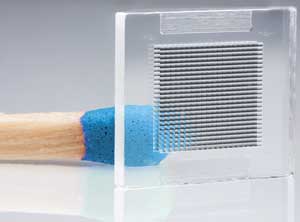
Figure 2. Complex polymer optics design: A double-sided plastic microlens array combines the injection molding specialty of Jenoptik Polymer Systems with the design and manufacturing expertise of the micro-optics unit of Jenoptik Optical Systems Inc. in Huntsville, Ala. The gray-scale lithography-generated glass master is used to create an electroformed negative, which is then used as the mold insert. Proprietary tooling allows for accurate alignment of the front and back sides of the mold.
“The decision when to use polymers is an engineering consideration, no different from deciding which type of glass to use,” said William S. Beich, director of sales and marketing at G-S Plastic Optics in Rochester, N.Y. “It depends on the application, and in some cases, the ability of the designer to compensate for the shortcomings of the material.”
Recent advances
In the past decade, plastic optics have exploded into a wide range of everyday applications including LED lenses, optical scanners, cellphone cameras and displays. Injection molding advances have greatly improved the optical quality of plastics so that they are becoming more common in growing nonconsumer markets such as medical equipment, biometrics and sensing.
Polymer injection molding lends itself nicely to LEDs because of its ability to integrate optical elements into one part with mechanical features such as snaps, apertures, holes, barrels, light pipes and mirrors (Figure 3), said Andreas Maahs, site manager of polymer operations at Jenoptik Polymer Systems GmbH in Jena, Germany. “Combining several optical features in one component allows smaller unit sizes and eliminates the need for an optical alignment assembly, which improves replicated tolerance, unit manufacturing cost and nonrecurring expenses.”
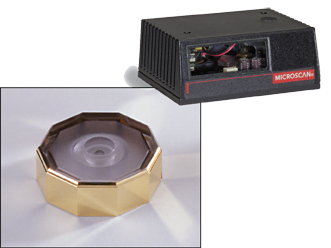
Figure 3. Everyday applications: The MS-820 bar-code scanner, designed and manufactured by Microscan Systems Inc. of Renton, Wash., involves numerous plano-optical surfaces on a polygonal mirror, integrated with a mounting datum into one part.
Applications for LEDs are booming. “LED lighting is a huge and growing market for polymer optics,” Beich said. “The advantages of using polymer optics comes from the ability to replicate very complex shapes in a cost-effective manner, using injection molding.” With the incorporation of LEDs into low-cost, efficient illumination everywhere, on the street, in buildings and in mobile ambient applications such as in trains, planes and automobiles, the high volume and low cost of polymer are key.
Zeon Corp., a Tokyo-based supplier of optical-grade polymers, recently announced the development of a high-transparency thermoplastic resin called Zeonex K26R, specifically for use in smartphone- and tablet-PC camera lenses. This material enables a 50 percent thinner lens element compared with conventional lenses used in mobile imaging applications, while still maintaining low birefringence (Figure 4).3
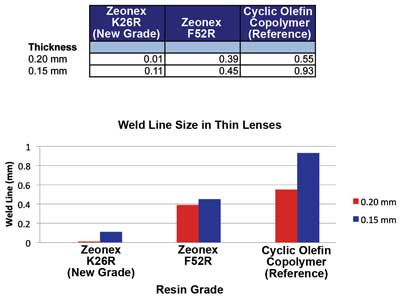
Figure 4. New materials: The new Zeonex K26R polymer resin, designed for microlens applications such as camera optics for smartphones and tablets, enables high-precision molding of thin cross-section lenses with significant reduction in weld line size and lower birefringence compared with traditional resins.
“This new plastic reportedly enables a lens only 0.15 mm thick, which is amazingly thin,” Cahall said.
Glass manufacturing also has made advances in recent years, according to Jenoptik’s Maahs. “The equipment used in precision glass molding technology has been very innovative, especially in high-volume manufacturing. Aspherical surfaces can be replicated at more reasonable costs than ever. Even some limited integrated features can be accomplished, although not with the same degree of freedom as with polymer.”
Recent advances in testing and quality-assurance capabilities ensure the quality of plastic. At G-S Plastic Optics, an OGP Smart Scope optical coordinate measuring system checks the mountings and assembly fiducials on molded products, holes and planar-shaped surfaces. Another high-performance coordinate measuring system certifies dimensional accuracy and product uniformity. Aspheric and other surface shapes are characterized using high-resolution stylus profilometry technology and phase-measuring laser interferometry in conjunction with computer-generated holograms. And the sphericity and irregularity of spherical optical surfaces such as mold inserts and molded optics are measured using phase-measuring laser interferometry (Figure 5).
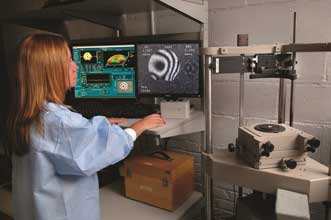
Figure 5. Advanced testing: The sphericity and irregularity of spherical optical surfaces such as mold inserts and molded optics are measured using phase-measuring laser interferometry.
‘A matter of physics’
Knowing that polymer keeps making inroads into glass quality territory, will polymer optics ever completely replace glass in the photonics world?
No, agree the experts. “It’s a matter of physics,” Beich said.
Plastics with significant aspheric departure are useful for aberration correction, but various types of materials are limited in plastic. Glass has the advantage of many material options, which is also useful for aberration correction.
“Clearly, plastic does and will continue to dominate for some applications such as cellphone cameras, disposable medical apps and any case where surface shapes are not conducive to glass fabrication,” Cahall said. “The optimal choice depends on the details of the application. Both plastic and glass will continue to be used for the foreseeable future.”
And sometimes they’ll be used together in polymer-glass hybrid optical systems. Polymer optics can be combined in systems with glass optics to take advantage of the benefits of both.
“An appropriate glass lens can be used to correct chromatic aberrations,” Beich said, “while the aspheric polymer lenses in the system can be used to correct for spherical and other aberrations. Such an arrangement also takes advantage of the fact that one can replicate aspheric surfaces very efficiently by injection-molding the optic.”
“I believe hybrid systems have a strong future,” Cahall said. “In many applications, they provide a preferred balance of cost and performance versus what’s possible with all-glass or all-plastic solutions.”
Whether a design calls for straight-up polymer optics or a polymer-glass hybrid system, consulting an experienced specialist in polymer optics is critical. “I think [optical design pioneer] Warren Smith said it best,” Beich said: “ ‘In considering a venture into the plastic optics arena, one is well-advised to seek out a specialist in making plastic optics. Not only is the typical injection molder incapable of making good optics, but he or she also has no conception of what is required to do so.’ ” 4
The plastic future
Where will polymer optics go in the next five to 10 years? It will continue to be a key enabling technology for laboratory instruments, LED illumination applications, and small, portable, lightweight devices in a wide spectrum of markets, Beich said. “For example, we have customers who are employing sophisticated spectrometry techniques that were once used only in laboratories. Because of advances in the science, what was once a lab-based instrument can now be carried around by a user.”
Also, developments in advanced optical data networking and optical computing will definitely benefit from polymer optical solutions, Maahs said.
“We will certainly continue to see plastics in high-volume imaging and nonimaging applications,” Cahall said. “Imaging systems in particular are increasingly becoming high-end. Cellphone cameras today, for example, typically offer greater than 5 megapix and are generally all plastic. The goal will be to push the lenses to even higher quality – no surprise. At the same time, we will continue to see the scale of lenses pushed smaller.
“Also, the number of consumer and medical applications where we see optical sensors and cameras will grow. This will be good for plastics and the optics industry in general.”
Meet the author
Freelance science and technology writer and editor Valerie C. Coffey is the founder of Stellar Editorial Services in Boxborough, Mass.; email: [email protected].
References
1. P. Tolley (October 2003). Polymer optics gain respect. Photonics Spectra, pp. 76-79.
2. J.G. Smith et al (2008). High efficiency micro-optics for illumination in projection systems. White paper. Mems Optical Inc.
3. http://www.zeonex.com/press/ZeonexK26R.asp.
4. W.J. Smith (2000). Modern optical engineering: The design of optical systems. 3rd ed., McGraw-Hill, New York, p. 190.